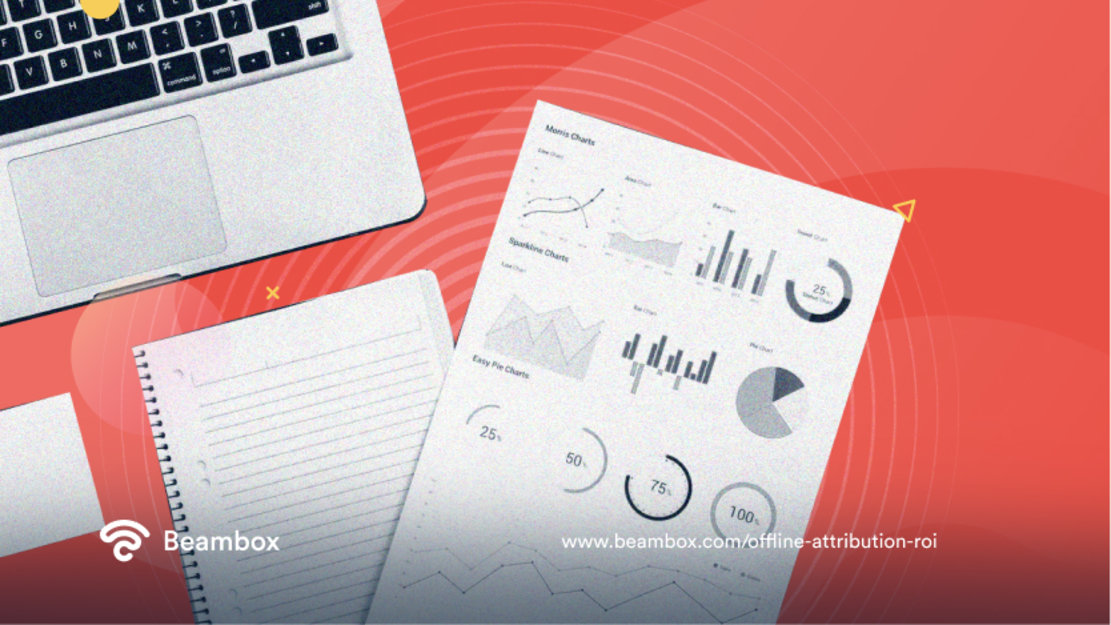Offline Attribution ROI: Does It Matter for Businesses?
“Did the Facebook ad drive any sales?” “Did it generate the targeted ROI?” “Was it worth the money?”. If you are a business owner facing doubts like these, calculating offline attribution ROI might be just what you need.
But ROI attribution is easier said than done. Surveys have revealed that 55.4% of people use their smartphones to make purchases.
Without a measurement model, it is impossible to know how many of the remaining 44.6% contributed to the ROI because of digital marketing.
In this article, we cover the ins and outs of offline attribution ROI: how to measure it, what factors to consider, and the best methods to calculate it.
What Is Marketing ROI?

Before talking about offline attribution ROI, let’s give a definition of ROI.
This term is short for Return on Investment. It is a mathematical formula used to measure the success of investments. ROI is also one of the most important metrics for better business planning.
In marketing, it is the comparison between the revenue earned through purchases and the cost of marketing campaigns.
Businesses must consider organic sales when calculating marketing ROI to get the most accurate number. Hence, the best formula to calculate marketing ROI is:
> Marketing ROI = (Sales Growth – Organic Sales Growth – Marketing Cost) / Marketing Cost
This includes purchases from social media campaigns, TV ads, email marketing, and print ads.
Calculate a percentage for each campaign to gain better visibility into your marketing.
What Is Offline Attribution?
Offline attribution is a term used to measure the impact of marketing, both online and offline marketing, on in-store or real-life results.
Let’s understand this with an example: Suppose you own a skincare brand. After launching a new facewash range, you decided to run an ad on Facebook or an alternative ad platform. A woman saw the ad and clicked on your shop link but didn’t buy the product.
A week later, she came to your store and made a purchase. Without measuring offline attribution, you wouldn’t know that your ad campaign was the reason for this purchase.
In the B2B world, conversion is more complicated. After seeing your ad, you would either need the business to fill out a form or come on a call. But even if one of these things happens, how do you know if they bought anything?
That is where offline attribution comes into play. It is the act of linking your online efforts to your offline results. You can measure offline attribution ROI using the following:
- Visit attribution: The number of people who came to your store or called due to your marketing.
- Spend attribution: The number of people who spent money and made purchases due to your marketing.
Offline ROI Attribution: 5 Methods To Calculate It
Calculating online attribution is easy, with built-in tools showing your campaign analytics. But data is the most important thing when it comes to offline attribution.
To calculate ROI attribution, the first step is to track and analyze your offline sales. Then trace those back to the advertising campaign that generated those leads. The next step is to calculate the revenue, and only then can you calculate the ROI.
With marketing spread across different channels, having a consistent approach is crucial. Here are some of the best methods to calculate offline attribution ROI:
Offline Attribution ROI Method #1: Use Customized URLs and Landing Pages
You can use custom landing pages or URLs for each campaign to collect data and measure offline attribution ROI. When a person accesses the URL of a particular ad, you can measure its effectiveness.
Think of this as providing your customers with more information about what they saw offline. You can easily track the analytics of these landing pages, which gives you more clarity about your offline ad.
Here are some points to keep in mind when creating custom landing pages and URLs:
- Keep the URLs as related to your brand as possible. Use your brand name and your industry.
- Make sure that the URL is short and memorable.
- Test the URL beforehand and test if Google Analytics is tracking effectively.
- Use the “no index” meta tag. This helps to prevent unwanted traffic.
Offline Attribution ROI Method #2: Use Dedicated Promo Codes and QR Codes

Promo codes are another great way to measure offline attribution ROI. These not only provide you with the insights you need, but they also help create brand loyalty. No matter how small or big, the discount is, promo codes never fail to grab attention.
Use different promo codes for each campaign. When a customer uses the promise in the store to avail of the discount, you can track the purchase back to the ad.
The same goes for QR codes which a person scans to access your webpage. QR codes are even better than landing pages because they are easier to use.
Offline Attribution ROI Method #3: Track Mobile Location
You can track a customer’s journey to the offline purchase by adding a location footprint. The location also helps you see how many people visited your store and bought something.
Geo-fencing can help to calculate offline attribution ROI. GPS technology creates a boundary. Whenever a person enters this boundary, he gets a notification, ad, or some type of brand messaging.
You can measure the effectiveness of your marketing if he takes some action in response.
You can also use geo-location to create personalized campaigns. This helps you attract and engage with customers.
Offline Attribution ROI Method #4: Track Your Calls
Tracking customer calls is another effective method of calculating offline attribution ROI. Assigning a custom number to each campaign to pinpoint which ad drove the call.
The only problem is even if you receive calls, there is no way to know how many of them resulted in a monetary benefit.
Therefore, use dedicated software to track calls and differentiate between them.
It is also a good idea to record these calls. This can help you create targeted campaigns for the calls that did not generate a monetary benefit.
Offline Attribution ROI Method #5: Combine Online and Offline Data
The best online data sources are customer reactions to digital campaigns and online transactions are the best online data sources. Other methods include browser cookies and customer service chat logs. This type of data is easy to collect.
But when it comes to offline data, there is more effort involved. You can get this data from surveys, research, CRM, sales, and loyalty card information.
After collecting these, you can combine them and create firm customer profiles. These profiles help you measure offline attribution ROI and gain completely new customers.
Offline Attribution ROI: 4 Factors To Consider When Calculating It
Each campaign differs from the other, whether it is online or offline. Consider these factors to generate accurate results for ROI attribution.
- Marketing team: Efforts of the marketing team can also affect the ROI of a campaign. Make sure to document the entire process to keep tabs on any mistakes.
- Aim: The goal is a core factor in calculating ROI attribution. Is the campaign meant to spread awareness, drive traffic or increase sales? Proceed to calculation after answering this. You will find the results drastically varying for campaigns with different aims.
- Industry: Determine a monetary benefit for your business before calculating offline attribution ROI. For example, for a blogger, views are currency. For a retail business, purchases are currency.
- External factors: Your business interacts with the outside world at all times. Weather conditions, economic conditions, and seasonality can also factor into your attribution ROI.
Can You Measure Offline Attribution ROI Manually?

Yes, it is possible to calculate offline attribution ROI manually. But it is a very complex and time-consuming process. Moreover, it does not produce accurate results and may lead to confusion.
Even with the tools’ help, calculating ROI attribution is challenging. Let’s dig deeper into the process to understand why manually calculating is difficult.
Being a business owner, you cannot attend to these tasks as you have other processes to look after. And even if you hire a team to do it manually, the results will not be precise, and you might waste money.
Measuring Offline Attribution ROI Using Software
Use dedicated software like Customer Data Platforms (CDPs) to measure offline attribution ROI. This is an easier and faster process that generates accurate results.
A CDP helps you track a customer’s journey across multiple touchpoints. It also helps you tie the results back to specific marketing campaigns. Here is how you can go about calculating attribution ROI using software:
- The first step is to choose a CDP or Wi-Fi marketing software to track and analyze offline sales.
- The next step is to set up the tracking in the software of your choice. Choose the options that best suit your business.
- Then use the software’s tools to analyze data and find the impact of your marketing on offline sales.
- Calculate the revenue generated from each campaign. Then compare it with the cost to calculate the ROI.
Using software to calculate offline attribution ROI saves time and money. It also helps automate tasks, gain accurate results, and understand the potency of your marketing.
Plan and budget for future campaigns based on the preference of your target audience.
5 Challenges Faced When Measuring Offline Attribution ROI
Sometimes business neglect or ignore offline attribution ROI. This is because it poses many challenges for business owners.
Some of these challenges are:
- Limited data availability: Gathering data on offline sales can be difficult. You need customers to provide this data through surveys and loyalty programs. But people don’t always provide information voluntarily. Methods like coupons, geo-location, and Wi-Fi marketing help solve this.
- Delayed attribution: Customers don’t necessarily buy right after interacting with a campaign. It may take them days or even weeks to come to a decision. This delay can make attributing the sale to a particular campaign difficult. This survey by Marketing Charts reveals that out of 900 people, 76.6% took at least four months to make a buying decision.
- Cross-channel interactions: Customers come to a buying decision after a complex journey. Suppose a person went to your website after interacting with your Facebook ad. But he didn’t buy anything. The next day, he saw your Instagram ad, and this time, he made a purchase. This journey will make it difficult for you to pinpoint exactly which campaign led to the sale.
- Attribution models: Offline attribution ROI needs a model like last-click, first-click, linear, and time-decay. And each has its advantages and disadvantages. Choosing the right model for your business can be a challenge. Some of these models work better with specific companies or industries. This makes a choice harder.
- Privacy concerns: Tracking customer data raises questions, especially with regulations like GDPR and CCPA. These can limit the type and scope of the data you collect.
More and more businesses are beginning to understand the importance of offline attribution ROI. This paved the way for various emerging tools to cope with these challenges.
What Is Profit Attribution Analysis?
Profit attribution analysis shows the impact of marketing on the overall profit of a business.
Here is what you need to do to perform this analysis. Break down the revenue generated by different marketing channels or campaigns. Then attribute the profit generated by each campaign to its costs.
Multi-touch attribution and marketing ROI analysis help perform profit attribution analysis. They help determine the direct and indirect costs of a campaign as well as the profit generated by it.
Businesses can use this analysis to divide marketing budgets effectively and optimize marketing campaigns. Which, in return, helps make better decisions.
Why Offline Attribution ROI Matters for Businesses?

Offline attribution ROI is as important as marketing itself. This is because, without insights, you can measure the outcome of your marketing strategies. It matters for businesses because it can help them:
- Track and analyze their offline sales.
- Measure the effectiveness of their campaigns.
- Gain insights into customer behavior.
- Create optimized campaigns.
- Make better marketing decisions.
- Identify marketing loopholes.
- Encourage better collaboration between the online and offline teams.
Final Thoughts: Offline Attribution ROI
To conclude, offline attribution ROI is a valuable tool for businesses. It helps them measure the potency of their marketing on offline sales. Collect data, analyze it, and then calculate the revenue and ROI of a campaign to measure it.
It helps businesses track a customer’s journey from marketing to offline sales. This gives them valuable insights, effectively divides resources, and identifies improvement areas.
Are you interested in an effective WiFi marketing solution? have a look at Beambox WiFi marketing.
Get Started With Free WiFi Marketing
Beambox helps businesses like yours grow with data capture, marketing automation and reputation management.
Sign up for 30 days free


